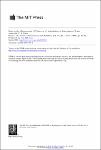Item Infomation
Full metadata record
| DC Field | Value | Language |
|---|---|---|
| dc.contributor.author | Polak. J. J. | - |
| dc.date.accessioned | 2024-08-13T00:54:58Z | - |
| dc.date.available | 2024-08-13T00:54:58Z | - |
| dc.date.issued | 1950 | - |
| dc.identifier.uri | http://www.jstor.org/stable/1928269 | - |
| dc.identifier.uri | http://thuvienso.thanglong.edu.vn//handle/TLU/10632 | - |
| dc.description.abstract | The elasticity of export supply, as can be seen, is an increasing function of each of three variables: the elasticity of supply of the ex ported goods, the proportion of potential ex ports consumed domestically, and the elasticity of the domestic demand for these potential ex ports. Certain of the results in the text, again, are stated in terms of one or more of these components separately, to the exclusion of the resultant, ex. As in the demand case, the math ematical development is simpler if e, be used alone and the components regarded as acting through this one term. There is no substantive difference between the two treatments, and similar relationships can be derived on the im port side with equal ease. | vi |
| dc.language.iso | en | vi |
| dc.publisher | The Review of Economics and Statistics, | vi |
| dc.relation.ispartofseries | Vol. 32, No. 1 (Feb., 1950);pp. 16-20 | - |
| dc.subject | Measurement of Elasticity | vi |
| dc.subject | International Trade | vi |
| dc.subject | IE405 | vi |
| dc.title | Note on the Measurement of Elasticity of Substitution in International Trade | vi |
| dc.type | Bài báo/Newspaper | vi |
| Appears in Collections | Lĩnh vực Khoa học quản lý | |
Files in This Item:



